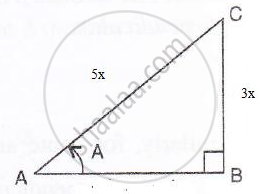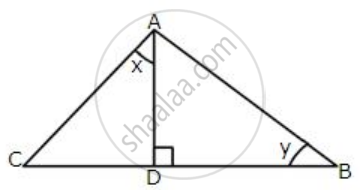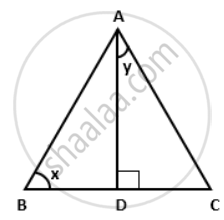Advertisements
Advertisements
प्रश्न
Given : sin A = `(3)/(5)` , find : (i) tan A (ii) cos A
उत्तर
Consider the diagram below : 
sin A = `(3)/(5)`
i .e. `"perpendicular"/"hypotenuse" = (3)/(5) ⇒"BC" /"AC" = (3)/(5)`
Therefore if length of BC = 3x, length of AC = 5x
Since
AB2 + BC2 = AC2 ...[ Using Pythagoras Theorem ]
AB2 + (3x)2 = (5x)2
AB2 = 25x2 – 9x2 = 16x2
∴ AB = 4x (base)
Now
(i) tan A = `"perpendicular"/"base" = (3x)/(4x) = (3)/(4)`
(ii) cos A = `"base"/"hypotenuse" = (4x)/(5x) = (4)/(5)`
APPEARS IN
संबंधित प्रश्न
If cot θ = `3/4` , show that `sqrt("sec θ - cosecθ"/"secθ + cosecθ" ) = 1/ sqrt(7)`
If A = 300 , verify that:
(i) sin 2A = `(2 tan A)/(1+tan^2A)`
Given: sin θ = `p/q`.
Find cos θ + sin θ in terms of p and q.
In the following figure:
AD ⊥ BC, AC = 26 CD = 10, BC = 42, ∠DAC = x and ∠B = y.
Find the value of :
(i) cot x
(ii) `1/sin^2 y – 1/tan^2 y`
(iii) `6/cos x – 5/cos y + 8 tan y`.

In the diagram, given below, triangle ABC is right-angled at B and BD is perpendicular to AC.
Find:
(i) cos ∠DBC
(ii) cot ∠DBA

In ΔABC, ∠B = 90°. If AB = 12units and BC = 5units, find: sinA
If cosB = `(1)/(3)` and ∠C = 90°, find sin A, and B and cot A.
In the given figure, AD is the median on BC from A. If AD = 8 cm and BC = 12 cm, find the value of sin x
If cosec θ = `(29)/(20)`, find the value of: cosec θ - `(1)/("cot" θ)`
Statement A (Assertion): For 0 < θ ≤ 90°, cosec θ – cot θ and cosec θ + cot θ are reciprocal of each other.
Statement R (Reason): cosec2 θ – cot2 θ = 1
